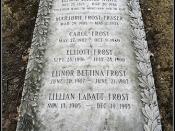Imagery has always been a powerful mode of forcing the reader to experience poetry as it was meant to. In "The Blue Heron", the poet, Theodore Roberts, uses a variety of color to engage the audience in the vivid imagery he presents. He tries to create a happy scene in the mind's eye; one of health and untainted natural beauty. He describes the scene with "green lanced through/ With amber and gold and blue", describing the flora and bodies of water that fill the area. He also describes the "roses pinker than dawn", insinuating the rich floral beauty and abundance of nature that exists in the area. Then the poem takes on a more somber tone, with images of "grey ... embers of yesterday" and "grey feather." The toned down, dark colors have a negative effect on the feelings that the reader experiences, and that helps the poet get the sentiments that he means to across.
This contrast of the bright colors against the darker colors also signifies how the blue heron is viewed by the poet. He seems to portray the bird as a two faced mystery, showing itself as a mindless creature that barely understands that which is around it, but with hidden grievances against the world. Images of the heron being "still as an image made/ Of mist and smoke" but with "eyes [that] are alive like gems" makes the audience hold a view of the heron as being an animal that holds a grudge against something. Using these powerful, vivid images, not only does Roberts convey his message, but he also forces people to think about how things are not always what they seem.



Colors in the blue heron
Colors imply many meanings you gave some nice examples of imagery through the many colors.
3 out of 3 people found this comment useful.